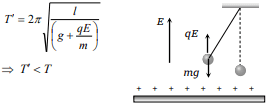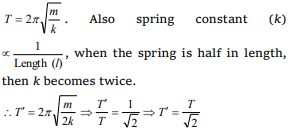1. A simple pendulum is vibrating in an evacuated
chamber, it will oscillate with
a) Increasing amplitude
b) Constant amplitude
c) Decreasing amplitude
d) First (c) then (a)
Explanation: As it is clear that in vacuum, the bob will not experience any frictional force. Hence, there shall be no dissipation therefore, it will oscillate with constant amplitude.
2. If a body is released into a tunnel dug across the
diameter of earth, it executes simple harmonic
motion with time period
a) \[T=2\pi\sqrt{\frac{R_{e}}{g}}\]
b) \[T=2\pi\sqrt{\frac{2R_{e}}{g}}\]
c) \[T=2\pi\sqrt{\frac{R_{e}}{2 g}}\]
d) T = 2 seconds
Explanation: \[T=2\pi\sqrt{\frac{R_{e}}{g}}\]
3.A simple pendulum has time period T. The bob is
given negative charge and surface below it is
given positive charge. The new time period will
be
a) Less than T
b) Greater than T
c) Equal to T
d) Infinite
Explanation: In this case time period of pendulum becomes

4. What effect occurs on the frequency of a
pendulum if it is taken from the earth surface to
deep into a mine
a) Increases
b) Decreases
c) First increases then decrease
d) None of these
Explanation:

5. Two bodies M and N of equal masses are
suspended from two separate massless springs of
force constants \[k_{1}\] and \[k_{2}\] respectively. If the two
bodies oscillate vertically such that their
maximum velocities are equal, the ratio of the
amplitude M to that of N is
a) \[\frac{k_{1}}{k_{2}}\]
b) \[\sqrt{\frac{k_{1}}{k_{2}}}\]
c) \[\frac{k_{2}}{k_{1}}\]
d) \[\sqrt{\frac{k_{2}}{k_{1}}}\]
Explanation:

6. A spring has a certain mass suspended from it
and its period for vertical oscillation is T. The
spring is now cut into two equal halves and the
same mass is suspended from one of the halves.
The period of vertical oscillation is now
a) \[\frac{T}{2}\]
b) \[\frac{T}{\sqrt{2}}\]
c) \[{\sqrt{2}}T\]
d) 2 T
Explanation:

7. Two masses \[m_{1}\] and \[m_{2}\] are suspended together
by a massless spring of constant k. When the
masses are in equilibrium, \[m_{1}\] is removed without
disturbing the system. Then the angular
frequency of oscillation of \[m_{2}\] is
a) \[\sqrt{\frac{k}{m_{1}}}\]
b) \[\sqrt{\frac{k}{m_{2}}}\]
c) \[\sqrt{\frac{k}{m_{1}+m_{2}}}\]
d) \[\sqrt{\frac{k}{m_{1}m_{2}}}\]
Explanation:

8. In arrangement given in figure, if the block of
mass m is displaced, the frequency is given by

a) \[n=\frac{1}{2\pi}\sqrt{\left(\frac{k_{1}-k_{2}}{m}\right)}\]
b) \[n=\frac{1}{2\pi}\sqrt{\left(\frac{k_{1}+k_{2}}{m}\right)}\]
c) \[n=\frac{1}{2\pi}\sqrt{\left(\frac{m}{k_{1}+k_{2}}\right)}\]
d) \[n=\frac{1}{2\pi}\sqrt{\left(\frac{m}{k_{1}-k_{2}}\right)}\]
Explanation:

9. Two identical spring of constant K are connected
in series and parallel as shown in figure. A mass
m is suspended from them. The ratio of their
frequencies of vertical oscillations will be

a) 2 : 1
b) 1 : 1
c) 1 : 2
d) 4 : 1
Explanation:

10. A mass m is suspended from the two coupled
springs connected in series. The force constant for
springs are \[k_{1}\] and \[k_{2}\] . The time period of the
suspended mass will be
a) \[T=2\pi\sqrt{\left(\frac{m}{k_{1}+k_{2}}\right)}\]
b) \[T=2\pi\sqrt{\left(\frac{m}{k_{1}-k_{2}}\right)}\]
c) \[T=2\pi\sqrt{\left(\frac{m\left(k_{1}+k_{2}\right)}{k_{1}k_{2}}\right)}\]
d) \[T=2\pi\sqrt{\left(\frac{m\left(k_{1}k_{2}\right)}{k_{1}+k_{2}}\right)}\]
Explanation:
